ASUS K53E: Testing Dual-Core Sandy Bridge
by Jarred Walton on April 8, 2011 1:00 AM EST- Posted in
- Laptops
- Intel
- Sandy Bridge
- Asus
General Performance – Dual-Core Sandy Bridge vs. the World
So now we get to the numbers, and this is where some of the competing solutions will really take a beating. Let’s just cut straight to the chase and look at the graphs. We’ve highlighted the K53E in our standard bright green, with the ASUS U41JF in black, Apple's dual-core i5-2415M MBP13 in gold, and the quad-core i7-2820QM in yellow.
One interesting piece of information prior to the benchmark discussion is that despite having a theoretical maximum Turbo speed of 3.2GHz, we rarely see the i5-2520M hit that mark in testing. Using CPUID’s TMonitor utility, in the single-core Cinebench result we see both cores fluctuate between 800 to 3100MHz. It appears the Windows task scheduler isn’t quite sure how to best distribute the load, which is a common problem. However, in the multi-threaded Cinebench test the two CPU cores run at a constant 2.9GHz, as expected.

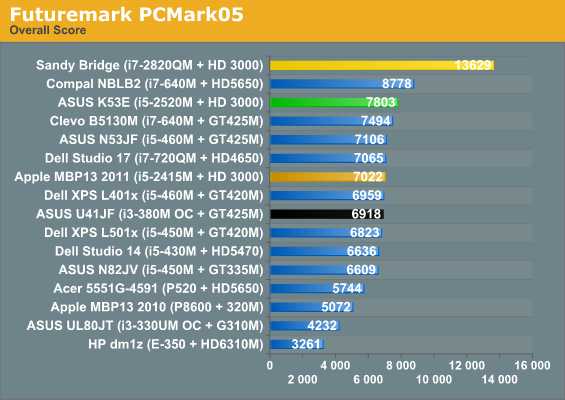
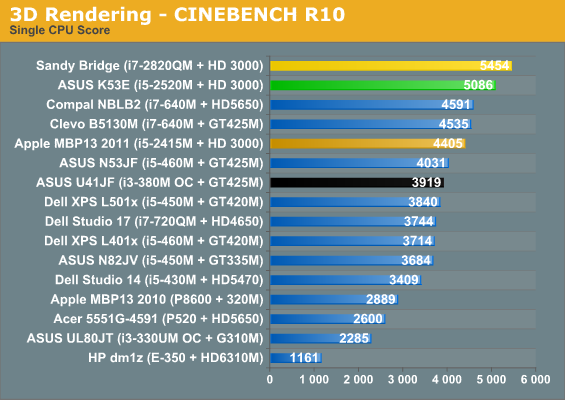
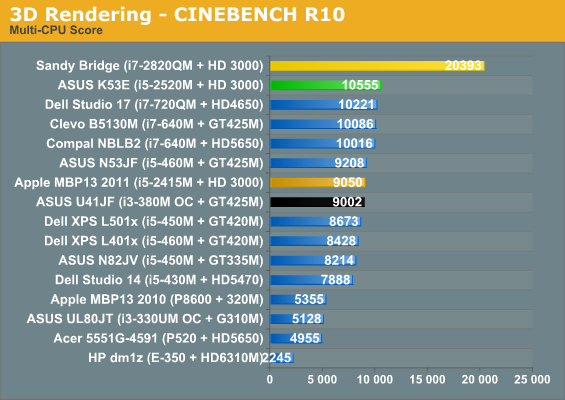
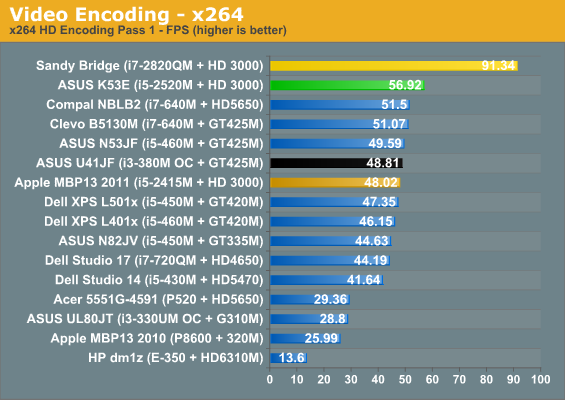

Starting with the new MBP13 comparison, the K53E with i5-2520M comes out an average of 20% faster. Some of that can be attributed to the hard drive differences, as PCMark Vantage shows Apple’s HDD choice is particularly poor, but the CPU intensive tasks are also 15 to 25% faster. It’s interesting that ASUS’ UL41JF happens to put in an overall showing in these applications that matches the MBP13, but that’s in a large part thanks to the 15% overclock. Looking at stock Arrandale CPUs, the i5-2520M turns in slightly higher performance results than the i7-640M, the highest-clocked Arrandale CPU we’ve tested. Even the old i7-720QM in the Dell Studio 17 fails to match the performance of the i5-2520M, which leads by an average of 18% in the above benchmarks (with the only loss coming in Pass 2 of x264 encoding).
Move up to quad-core SNB and an SSD, and of course the dual-core parts look a lot weaker. The i7-2820QM average lead in the above charts is 74%, but part of that is the thanks to the 104% lead in PCMark Vantage. Remove the PCMark results, though, and the 2820QM is still 65% faster than the 2520M. On the other side of the charts—literally—is AMD’s E-350. We know it’s not meant to compete with Sandy Bridge (or even Arrandale or Core 2 Duo), but keep in mind that the cheapest price for such a laptop is going to be around $450. On average, the i5-2520M lays the smack down hard and ends up roughly four times faster than an E-350. Ah, but the E-350 has a much better IGP, right? Well, maybe it’s better, but it’s certainly not faster than Intel’s HD 3000 when it’s bottlenecked by the CPU; here are some 3DMark results before we get to the games to give you an idea of how graphics performance compares.
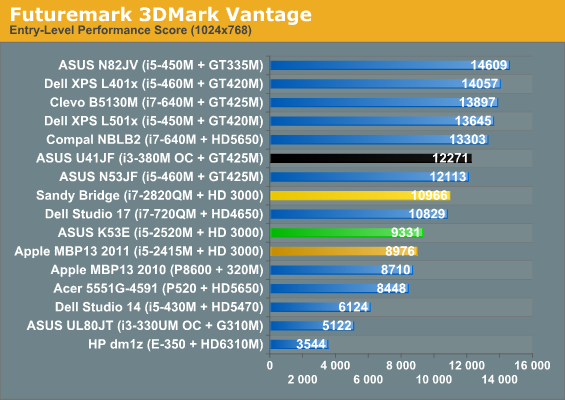
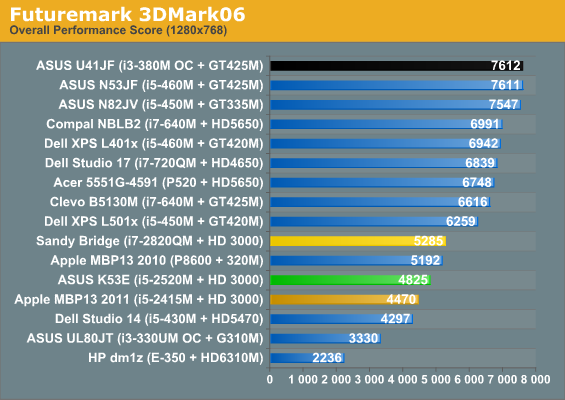
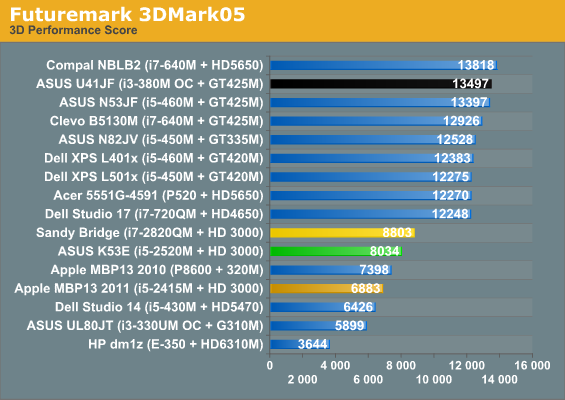
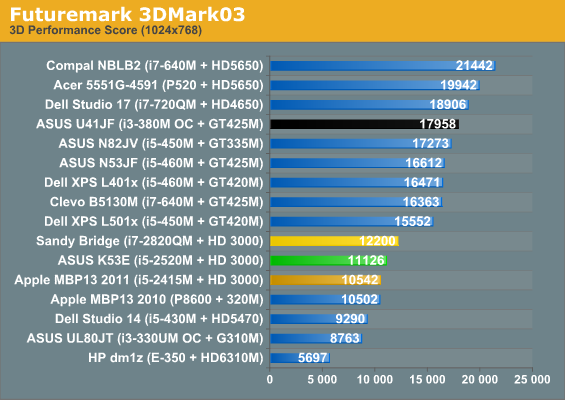
While we would never take 3DMark as the end-all, be-all of graphics performance comparisons, it does give a general idea of what we can expect. The K53E with i5-2520M turns in performance that’s 9% faster than the MBP13 on average across the four versions of 3DMark. That’s actually pretty accurate, as we’ll see in the gaming tests. Likewise, the i7-2820QM results end up being 12% faster than the 2520M, possibly from more aggressive IGP Turbo modes. Again, that matches what we’ll see in the games. On the other hand, even a middling dGPU like the GT 420M/425M still comes out 40-50% ahead of the HD 3000, and AMD’s HD 5650 is 60% faster on average.
What about AMD’s Fusion E-350 platform? If the 3DMark results hold in our actual gaming tests, Intel’s “horrible” HD 3000 IGP offers over twice the performance of the HD 6310M. In fact, even an Arrandale IGP would come within 10% of the E-350 results in 3DMark. It’s not that we love Intel or want them to pummel AMD, and we understand that the E-350 competes in a lower price bracket. Still, many people like to get carried away in discussions of how much better AMD’s graphics are compared to Intel’s IGP. That’s certainly true when you’re looking at discrete GPUs, and compatibility is still better with AMD and NVIDIA drivers, but the latest SNB IGP changed the status quo. HD 3000 works in about 90% of games (roughly estimating), performs well enough to be playable in about 80% of titles, posts scores that are competitive with HD 5470 and GT 320M (and often twice what the current Brazos can achieve), and you get it for free with any 2nd Gen Core i-series CPU. As a friend of mine is fond of saying, it’s hard to compete with “free”.










78 Comments
View All Comments
Tasslehoff Burrfoot - Friday, April 8, 2011 - link
I'm a little surprised this laptop has such a long battery life.If manufacturers put as good batteries to the fusion laptops as Asus put into this one they could last a looong, loong time.
krumme - Friday, April 8, 2011 - link
I have 97 Wh on my 2520 machine, and it last 10-12 hr for office work. Its just a little bit short even for light gaming for my 2-3 years old games imho, but besides from that, it just delivers in spades. The fan is never on, and the laptop is not hot. Even decoding hd there is only very, very little heat and noise.silverblue - Friday, April 8, 2011 - link
I think comparing the following two ASUS models would make interesting reading:http://www.newegg.com/Product/Product.aspx?Item=N8...
http://www.newegg.com/Product/Product.aspx?Item=N8...
The former is a Pentium with HD 5470 discrete graphics and carries a $100 price premium (and has recently been reduced $200).
Acer do a cheaper Brazos laptop, however it's much larger at 15.6":
http://www.newegg.com/Product/Product.aspx?Item=N8...
789427 - Friday, April 8, 2011 - link
I don't know but I just may be getting old.To me the notebooks are pretty much all fast enough unless you're going for a desktop replacement and quite frankly, I can't see myself without a desktop (I like my 23" monitor but would never carry it around)
My on the go machine is a compaq 311c with 7200rpm 500gb HDD - a netbook and I never find myself apologizing for it's slowness.
So I asked myself, what makes a notebook noteworthy...
1. The right screen for the form factor
2. Battery life
3. Capabilities: can it play Blu-ray? 720p?
4. Is it fast enough?
5. does the keyboard work - or is it a Sony (Sorry Sony - you produced the worst keyboard ever in your netbook - can't remember the model)
When I saw the AMD video of the new processors when a video was playing, excel calculating the hind legs off a donkey on Mars and switching between the lot, I realized that Benchmarks are extremely limited and don't have a relationship to the real-world .
Real world benchmark: Hours of blu-ray playback
Can I type emails, letters while watching a windowed movie?
Can I watch while running a photoshop batch conversion? Text recognition?
And for a gaming laptop - what games can I play...
Am I nuts? Probably but somehow I think AMD is on to something. Oh wait... Apple is already there. How else could they charge the prices they do for a last-gen Intel CPU? It's by focusing on the entire build - especially the screen and design.
cb
Pirks - Friday, April 8, 2011 - link
Apple did the right thing getting rid of this legacy shit and I'm waiting for other molasses slow PC vendors to follow their lead. You don't need any stupid touchpad buttons when you have tap, multitap and multitouch on your touchpad, it's 2011 not 2001 for ducks sake, why use legacy tech now? I don't get it. I never ever touched touchpad buttons on my Asus UL80Vt since its touchpad has same left right middle click and scroll with multitouch, Apple-like and pretty nice and convenient to use.Stop being such a retro man Jarred, let the museum stuff go, will ya? ;)
JarredWalton - Friday, April 8, 2011 - link
No thank you... I hate the Apple touchpad where you actually have to physically "click" it. Anyway, my point was that I'm glad there's no silly rocker button (i.e. UL80Vt) this time. I also happen to do things like pushing the left button and then dragging over an area to select. Yes, you can double-tap-and-drag, but that sucks IMO. Anyway, you know what they say about opinions and a-holes. :)DanNeely - Monday, April 11, 2011 - link
I have to agree with Jarred. Tap to click == fail.ProDigit - Friday, April 8, 2011 - link
I wonder when the first manufacturer is going to create a HTPC, booksized pc, or mini pc, with a mobile Corei7 chipset, together with a powerful mobile graphics card, or a very energy efficient desktop graphics card!I think there'd be a lot of interest in a 64 or 128GB SSD, 2 or 4 x 4GB 1800Mhz DDR3 memory, the corei7 2820-QM processor, an ATI Radeon HD 5000 or 6000 series graphics card that is not the best of the best, but offers highest quality dx11 gaming for 1080p screens, or fluid dx9 gaming on 3 screens, together with IR sensor and remote control, and uses very little power in standby.
I see plenty of sub $100 variants with too slow processors to play back 1080p video on a tv.
drajitsh - Saturday, April 9, 2011 - link
posting after nearly 10 years.Well having followed Anandtech continuously for 11 years I do know a little bit about computers. therefore I get a pretty fair idea of the performance from the specs online and most vendors will give pics of their systems so any glaring ergonomic defects will be visible.
Since sandybridge I just read the initial review for the platform, the for the subsequent reviews I go directly to the screen review. If, as is usually the case, the screen is pathetic I go back to my Galaxy Tab.
I am a surgeon, so my tablet and my old core 2 duo more than take care of the bulk of my needs -- mainly web surfing, having memorised the keyboard shortcuts I find the ribbon interface clunky and obsteperous and even office 97 would probably do all the work I need.n hence open office and google docs.
I am making do with my core 2 duo -- nice keyboard ( with real keys and not a chiclet monster) a 16:10 screen ( I have other options if I want to see movies and I like to see more of the webpages or documents). the one thing I cannot indulge is my hobby of photography. Probably will continue doing so till they come out with something with a better screen with a Adobe RGB gamut and taller than 16: 10.
I guess I will be waiting for sometime still.
ProDigit - Saturday, April 9, 2011 - link
quote:"There’s little (well, nothing really) to recommend an Atom netbook over a Brazos alternative at the $300 to $350 price bracket"
You forget battery life, which is important for many!
Atom netbooks have very low latency in audio applications, and have a long battery life.
I rather pay $300 for a netbook that does basic computing for 10 hours, than pay $400 for a neo that can do basic gaming, but only lasts 4 hours on battery!